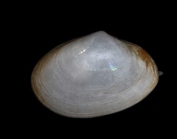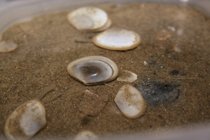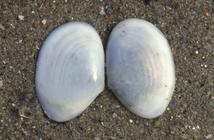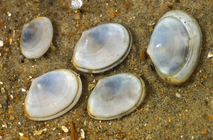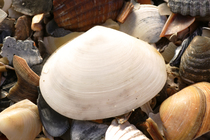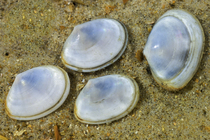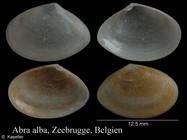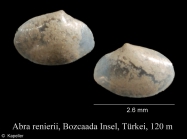Scheldt species taxon details
Abra alba (W. Wood, 1802)
141433 (urn:lsid:marinespecies.org:taxname:141433)
accepted
Species
marine, brackish, fresh, terrestrial
recent + fossil
(of ) Wood W. 1802. Observations on the hinges of British Bivalve shells. <i>Transactions of the Linnean Society of London</i>, 6: 154-176, pl. 14-18. , available online at http://biodiversitylibrary.org/page/758287
page(s): p. 165, pl. 16 fig. 9-12 [details] Available for editors
page(s): p. 165, pl. 16 fig. 9-12 [details] Available for editors
MolluscaBase eds. (2025). MolluscaBase. Abra alba (W. Wood, 1802). Accessed through: VLIZ Consortium Scheldt Species Register at: https://www.scheldemonitor.org/speciesregister/aphia.php?p=taxdetails&id=141433 on 2025-09-11
VLIZ Consortium. Scheldt Species Register. Abra alba (W. Wood, 1802). Accessed at: https://scheldemonitor.be/speciesregister/aphia.php?p=taxdetails&id=141433 on 2025-09-11
Date
action
by
original description
(of ) Wood W. 1802. Observations on the hinges of British Bivalve shells. <i>Transactions of the Linnean Society of London</i>, 6: 154-176, pl. 14-18. , available online at http://biodiversitylibrary.org/page/758287
page(s): p. 165, pl. 16 fig. 9-12 [details] Available for editors
context source (Schelde) Maris, T., O. Beauchard, S. Van Damme, E. Van den Bergh, S. Wijnhoven & P. Meire. (2013). Referentiematrices en Ecotoopoppervlaktes Annex bij de Evaluatiemethodiek Schelde-estuarium Studie naar “Ecotoopoppervlaktes en intactness index”. [Reference matrices and Ecotope areas Annex to the Evaluation methodology Scheldt estuary Study on “Ecotope areas and intactness index”. <em>Monitor Taskforce Publication Series, 2013-01. NIOZ: Yerseke.</em> 35 pp. (look up in IMIS) [details]
context source (BeRMS 2020) Marine Biology Section, Ugent. Belgium. INRAM. Benthic fauna monitoring- SSD - Belgian Science Policy., available online at http://www.vliz.be/projects/inram/imers.php. [details]
basis of record Gofas, S.; Le Renard, J.; Bouchet, P. (2001). Mollusca. in: Costello, M.J. et al. (eds), European Register of Marine Species: a check-list of the marine species in Europe and a bibliography of guides to their identification. <em>Patrimoines Naturels.</em> 50: 180-213., available online at http://www.vliz.be/imisdocs/publications/ocrd/254404.pdf [details]
additional source Dewarumez, J. M., Quisthoudt, C. and Richard, A. 1986. Suivi pluriannuel du peuplement a Abra alba dans la partie meridionale de la Mer du Nord (region du Dunkerque-France). Hydrobiologia 142: 1870-1197., available online at https://doi.org/10.1007/bf00026758 [details]
additional source Huber, M. (2010). <i>Compendium of bivalves. A full-color guide to 3,300 of the world's marine bivalves. A status on Bivalvia after 250 years of research</i>. Hackenheim: ConchBooks. 901 pp., 1 CD-ROM. (look up in IMIS) [details]
additional source Zamouri-Langar, N.; Chouba, L.; Ajjabi Chebil, L.; Mrabet, R.; El Abed, A. (2011). Les coquillages bivalves des côtes tunisiennes. Institut National des Sciences et Technologies de la Mer: Salammbô. ISBN 978-9938-9512-0-2. 128 pp. (look up in IMIS) [details]
additional source Webb C.M. (1986). Post-larval development of the tellinacean bivalves <i>Abra alba</i>, <i>Tellina fabula</i> and <i>Donax vittatus</i> (Mollusca, Bivalvia), with reference to the late larva. <em>Journal of the Marine Biological Association of the United Kingdom.</em> 66: 749-762. [details] Available for editors
redescription Wood W. 1802. Observations on the hinges of British Bivalve shells. <i>Transactions of the Linnean Society of London</i>, 6: 154-176, pl. 14-18. , available online at http://biodiversitylibrary.org/page/758287
page(s): 165 [details] Available for editors
identification resource Cosel, R. von; Gofas, S. (2019). <i>Marine bivalves of tropical West Africa: from Rio de Oro to southern Angola</i>. Publications Scientifiques du Muséum, Paris, IRD Éditions, Marseille (Faune et Flore tropicales, volume 48): 1-1104.
page(s): 679 [details]
page(s): p. 165, pl. 16 fig. 9-12 [details] Available for editors
context source (Schelde) Maris, T., O. Beauchard, S. Van Damme, E. Van den Bergh, S. Wijnhoven & P. Meire. (2013). Referentiematrices en Ecotoopoppervlaktes Annex bij de Evaluatiemethodiek Schelde-estuarium Studie naar “Ecotoopoppervlaktes en intactness index”. [Reference matrices and Ecotope areas Annex to the Evaluation methodology Scheldt estuary Study on “Ecotope areas and intactness index”. <em>Monitor Taskforce Publication Series, 2013-01. NIOZ: Yerseke.</em> 35 pp. (look up in IMIS) [details]
context source (BeRMS 2020) Marine Biology Section, Ugent. Belgium. INRAM. Benthic fauna monitoring- SSD - Belgian Science Policy., available online at http://www.vliz.be/projects/inram/imers.php. [details]
basis of record Gofas, S.; Le Renard, J.; Bouchet, P. (2001). Mollusca. in: Costello, M.J. et al. (eds), European Register of Marine Species: a check-list of the marine species in Europe and a bibliography of guides to their identification. <em>Patrimoines Naturels.</em> 50: 180-213., available online at http://www.vliz.be/imisdocs/publications/ocrd/254404.pdf [details]
additional source Dewarumez, J. M., Quisthoudt, C. and Richard, A. 1986. Suivi pluriannuel du peuplement a Abra alba dans la partie meridionale de la Mer du Nord (region du Dunkerque-France). Hydrobiologia 142: 1870-1197., available online at https://doi.org/10.1007/bf00026758 [details]
additional source Huber, M. (2010). <i>Compendium of bivalves. A full-color guide to 3,300 of the world's marine bivalves. A status on Bivalvia after 250 years of research</i>. Hackenheim: ConchBooks. 901 pp., 1 CD-ROM. (look up in IMIS) [details]
additional source Zamouri-Langar, N.; Chouba, L.; Ajjabi Chebil, L.; Mrabet, R.; El Abed, A. (2011). Les coquillages bivalves des côtes tunisiennes. Institut National des Sciences et Technologies de la Mer: Salammbô. ISBN 978-9938-9512-0-2. 128 pp. (look up in IMIS) [details]
additional source Webb C.M. (1986). Post-larval development of the tellinacean bivalves <i>Abra alba</i>, <i>Tellina fabula</i> and <i>Donax vittatus</i> (Mollusca, Bivalvia), with reference to the late larva. <em>Journal of the Marine Biological Association of the United Kingdom.</em> 66: 749-762. [details] Available for editors
redescription Wood W. 1802. Observations on the hinges of British Bivalve shells. <i>Transactions of the Linnean Society of London</i>, 6: 154-176, pl. 14-18. , available online at http://biodiversitylibrary.org/page/758287
page(s): 165 [details] Available for editors
identification resource Cosel, R. von; Gofas, S. (2019). <i>Marine bivalves of tropical West Africa: from Rio de Oro to southern Angola</i>. Publications Scientifiques du Muséum, Paris, IRD Éditions, Marseille (Faune et Flore tropicales, volume 48): 1-1104.
page(s): 679 [details]
 Present
Present  Inaccurate
Inaccurate  Introduced: alien
Introduced: alien  Containing type locality
Containing type locality
| Language | Name | |
|---|---|---|
| Dutch | witte dunschaal | [details] |
| English | white furrow-shellwhite furrow shellwhite abra | [details] |
BIOTIC
Encyclopedia of Marine Life of Britain and Ireland
Marine Life Information Network - UK
To Barcode of Life (14 barcodes)
To Biodiversity Heritage Library (74 publications)
To Dyntaxa
To European Nucleotide Archive, ENA (Abra alba)
To GenBank (18 nucleotides; 7 proteins)
To Global Biotic Interactions (GloBI)
To Malacopics (Abra alba (W. Wood, 1802) Netherlands, Zuid-Holland, Hoek van Holland, beached after storm, collected February 1998, ex coll. J. Trausel)
To Malacopics (Abra alba (W. Wood, 1802))
To Malacopics (Abra alba)
To Marine Bivalves of the British Isles webpage at National Museum of Wales
To PESI
To ITIS
Encyclopedia of Marine Life of Britain and Ireland
Marine Life Information Network - UK
To Barcode of Life (14 barcodes)
To Biodiversity Heritage Library (74 publications)
To Dyntaxa
To European Nucleotide Archive, ENA (Abra alba)
To GenBank (18 nucleotides; 7 proteins)
To Global Biotic Interactions (GloBI)
To Malacopics (Abra alba (W. Wood, 1802) Netherlands, Zuid-Holland, Hoek van Holland, beached after storm, collected February 1998, ex coll. J. Trausel)
To Malacopics (Abra alba (W. Wood, 1802))
To Malacopics (Abra alba)
To Marine Bivalves of the British Isles webpage at National Museum of Wales
To PESI
To ITIS
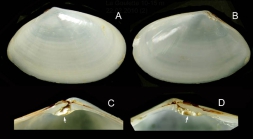
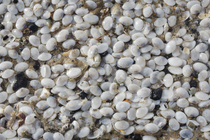


 renieri.jpg)
